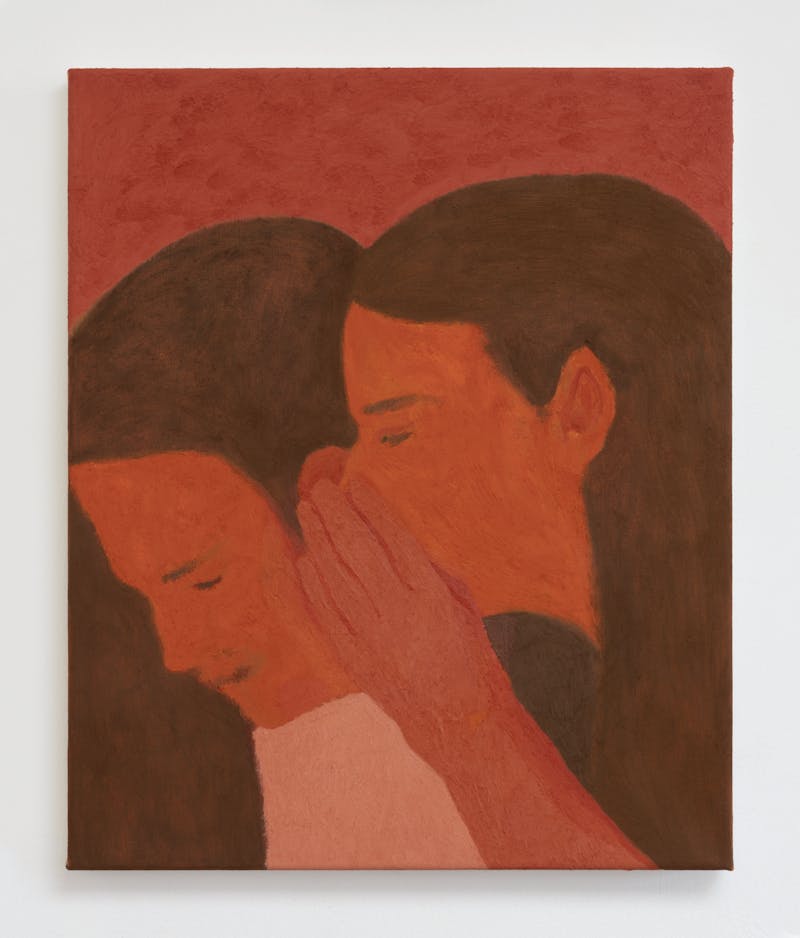Catherine Repko is accustomed to change, and to adapting, her childhood having been spent with stints in Italy, Germany, America, Ireland and England. All along, her sisters were a calming familiarity beneath the constantly changing roofs and she reminisces about their relationships before adulthood barged in. She sifts through the innumerable photographs her father took of them, her eye drawn to frivolous and fleeting moments of intimacy and proximity, a whisper shared. The longing she feels for her sisters, and perhaps the time before adulthood, has become the mainstay of her paintings; a constantly fascinating and unimpeded lens that rarely loses its clarity.
For Catherine, their bond speaks to wider unities among women, and she’ll often cogitate over Edgar Degas’ apricot-hued painting of a woman combing the hair of another woman or Vanessa Bell’s painting of three women conversing by a window. In Sister’s whispers, her sisters are synchronised and fused, each merging into the next through thoughts and conversation. A favourite painting of Catherine's is a beguiling composition of a man whispering into his lovers ear behind a bed of lilies by Co Westerik – the peach-tinged faces and matching brunette hair morphing into each other's. For Catherine, the painting lingers like rising steam in a slow breeze, her eyes continually enchanted by the seamless fusing of forms on canvas. You’ll notice her sisters similarly absorb into plains of monochrome colour – melded in telepathic harmony.

Catherine Repko, Spoken or unspoken, a wordlessness, 2022
Painting is a way of reliving her past, but also of reimagining it: a long drawn out passage that ceases to end, like a game of telephone, each painting another whisper across a chain. The story constantly changes, as do her sisters, who are almost always spared of defining facial features – Catherine prompting us to refract our own relations onto these unadorned heads. She’s constantly thickening the plot, metaphorically and physically, mixing her oils in powdered marble dust, commonly used to harden cement. Inspired by the surfaces of frescos – a method of mural painting onto lime plaster, Catherine concocts her oils into a gritty paste, vigorously stabbing at the canvas to disperse the pigment. On zooming closer you’ll notice the surfaces have the illusion of dried terracotta, their matte, mottled facades seeming almost to have been sculpted or formed by a potter. Other marks pick up the bristles from her brushes, which Catherine often ponders on by appreciating the thick swathes of strokes in Richard Diebenkorn’s landscapes, or Joan Mitchell’s exuberant impasto abstracts, as she adds more thick paint to the surfaces, each painting quickly calcifying, morphing drastically from the light crayons and washes they started as.
Catherine prefers working at night, her paintings brought to life when most are asleep. Of course her painted sisters stay wide awake with her, whispering and converging, their sand-like, frescoed faces accentuated by the fluorescence of the studio lights above. The paintings eventually fall sleep when marble dust is applied, the paint drying quickly. She’ll often paint repeated versions of the same scene – jostling from oil pastels in sketchbooks to scraps of card, finding more crops and angles to carve out of brush. Painter Milton Avery was continually pulled back to American landscapes for inspiration, painting the hills, shores and fields; Catherine is similarly fixated by her sisters and ‘their ineffable bond’, rolling back the years, each painting for ‘Sister’s whispers’ a distilling of a singular drawn out moment, as temporary as a cloudscape. Blink and you might miss it...